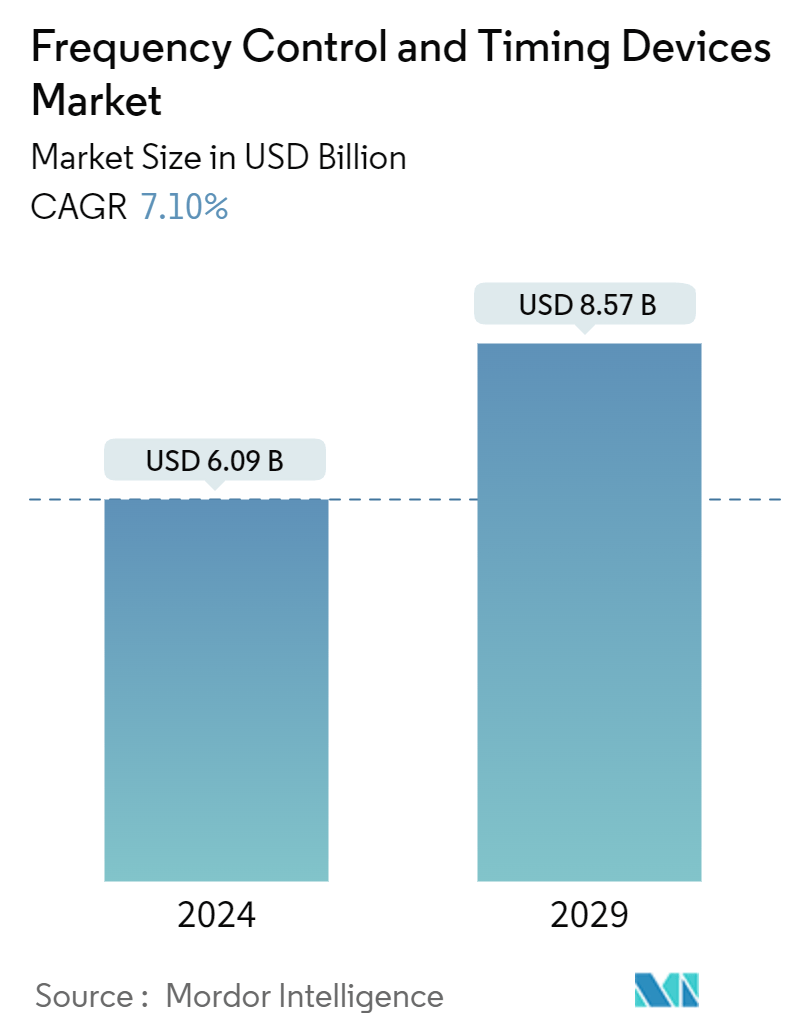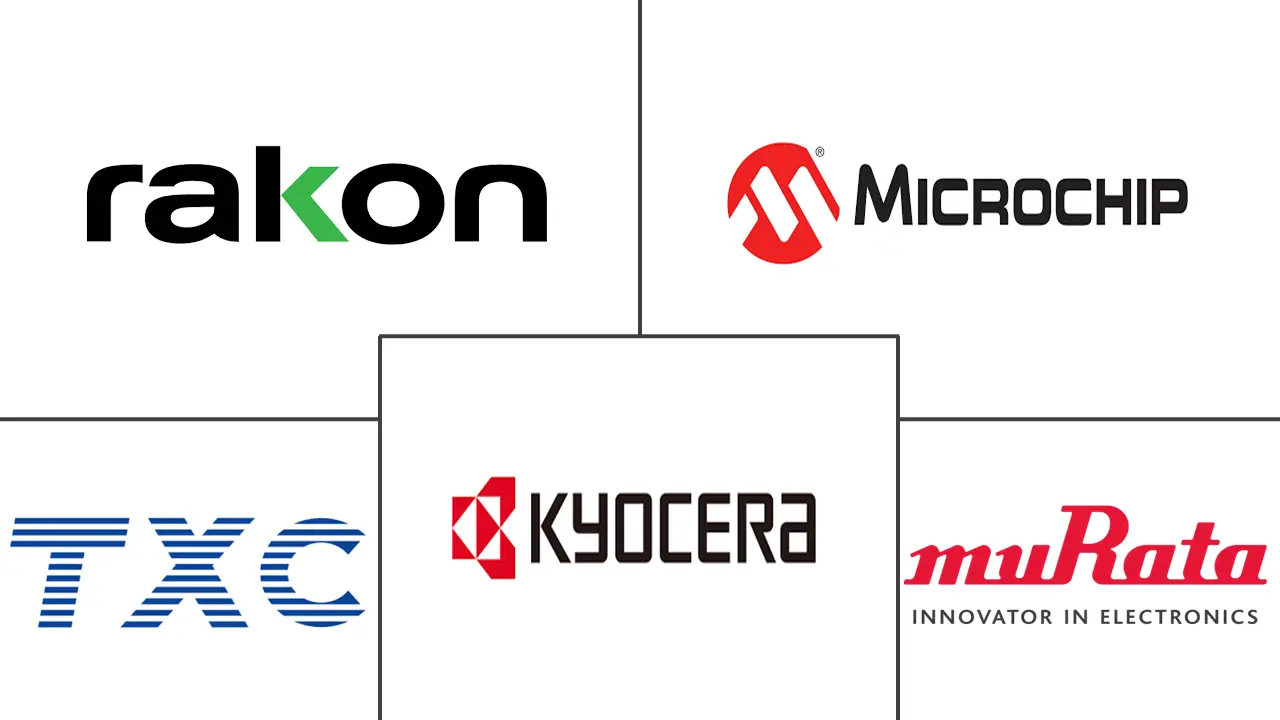Market Size of Frequency Control And Timing Devices Industry

| Study Period | 2019 - 2029 |
| Market Size (2024) | USD 6.09 Billion |
| Market Size (2029) | USD 8.57 Billion |
| CAGR (2024 - 2029) | 7.10 % |
| Fastest Growing Market | Asia Pacific |
| Largest Market | Asia Pacific |
Major Players
*Disclaimer: Major Players sorted in no particular order |
Frequency Control And Timing Devices Market Analysis
The Frequency Control And Timing Devices Market size is estimated at USD 6.09 billion in 2024, and is expected to reach USD 8.57 billion by 2029, growing at a CAGR of 7.10% during the forecast period (2024-2029).
Frequency control and timing devices (FCTD) are electronic components that generate, control, and synchronize timing signals in various electronic systems. They are crucial in ensuring accurate timing, synchronization, and coordination of operations within these systems. Applying the principles of timing devices to quartz crystals, MEMS, and ceramic resonators makes it possible to generate oscillations with stable frequencies. These timing devices help to ensure the precise operation of devices in Zigbee, Bluetooth, and other wireless applications (such as smartphones), automobiles, and medical equipment.
• The surging popularity of printed circuit boards (PCBs) is a key driver for the growth of the frequency control and timing devices market. Modern PCBs are becoming increasingly complex, with higher component density and functionality packed into smaller spaces. This complexity necessitates precise timing and signal integrity to ensure proper operation. FCTDs are important in managing these complexities by providing stable reference frequencies and signal integrity.
• Industrial organizations' efforts to accelerate digital transformation drive the market's growth. This includes shifting to the "industry 4.0" concept, which governs a higher adoption of automation, robotics, and advanced solutions such as AI and IIoT in industrial setups.
• The growing adoption of 5G technology worldwide significantly drives the growth of frequency control and timing devices. 5G networks utilize higher frequency bands, including millimeter-wave frequencies (24GHz and above), which require exact frequency control devices to maintain signal integrity and performance. With the expanded bandwidth capabilities of 5G, precise timing is essential to handle large amounts of data being transmitted and received, necessitating advanced oscillators and clock generators.
• The frequency control and timing devices market is a critical segment within the electronics industry, providing essential components for various applications. However, the high costs associated with developing and producing frequency control and timing devices are challenging the market's growth.
• Several macroeconomic trends, like economic growth, inflation, government spending priorities, global trade, and geopolitical dynamics, affect the defense budgets of various countries. According to the US Congressional Budget Office, defense spending in the United States is predicted to increase yearly until 2033. Defense outlays in the United States amounted to USD 746 billion in 2023, and the forecast predicts an increase to USD 1.1 trillion in 2033.
Frequency Control And Timing Devices Industry Segmentation
Frequency control and timing devices play a crucial role in electronic devices, providing signals that dictate the speed and timing of information transmission. They are instrumental in offering synchronizing signals and ensuring seamless operations in a variety of applications, including Zigbee, Bluetooth, smartphones, automobiles, and medical equipment.
The frequency control and timing devices market is segmented by type (crystals, oscillators (temperature compensated crystal oscillator (TCXO), voltage-controlled crystal oscillator (VCXO), oven-controlled crystal oscillator (OCXO), MEMS oscillator, and other types of oscillators), resonators), by end-user industry (automotive, computer and peripherals, communications/server/data storage, consumer electronics, industrial, military and aerospace, other end-user industries), and by geography (North America, Europe, Asia-Pacific, and the Rest of the World). The market sizes and forecasts are provided in terms of value (USD) for all the above segments.
| By Type | |||||||
| Crystals | |||||||
| |||||||
| Resonators |
| By End-user Industry | |
| Automotive | |
| Computer and Peripherals | |
| Communications/Server/Data Storage | |
| Consumer Electronics | |
| Industrial | |
| Military and Aerospace | |
| Other End-user Industries |
| By Geography*** | |
| North America | |
| Europe | |
| Asia | |
| Australia and New Zealand | |
| Latin America | |
| Middle East and Africa |
Frequency Control And Timing Devices Market Size Summary
The frequency control and timing devices market is poised for significant growth, driven by the increasing complexity of modern electronic systems and the rising adoption of advanced technologies such as 5G, AI, and IIoT. These devices are essential for ensuring accurate timing and synchronization in various applications, including consumer electronics, automotive systems, and industrial automation. The demand for frequency control and timing devices is further bolstered by the surging popularity of printed circuit boards, which require precise timing and signal integrity. Despite the high costs associated with their development and production, the market continues to expand, supported by macroeconomic trends and increased defense spending in key regions.
The Asia-Pacific region is expected to experience rapid growth in the frequency control and timing devices market, driven by the burgeoning smartphone industry, industrial automation, and the widespread adoption of 5G technology. Major economies like China and India are at the forefront of this growth, with significant contributions from South Korea's consumer electronics and telecommunications sectors. The market is characterized by intense competition, with key players such as Murata Manufacturing, Kyocera Corporation, and Rakon Limited focusing on product innovation and strategic partnerships. Recent advancements in crystal oscillators and other timing devices are enhancing efficiency and accuracy, further propelling market expansion across various industries.
Frequency Control And Timing Devices Market Size - Table of Contents
-
1. MARKET INSIGHTS
-
1.1 Market Overview
-
1.2 Industry Attractiveness - Porter's Five Forces Analysis
-
1.2.1 Bargaining Power of Buyers
-
1.2.2 Bargaining Power of Suppliers
-
1.2.3 Threat of New Entrants
-
1.2.4 Threat of Substitutes
-
1.2.5 Intensity of Competitive Rivalry
-
-
1.3 Value Chain Analysis
-
1.4 Analysis of Macroeconomic Trends on the Market
-
-
2. MARKET SEGMENTATION
-
2.1 By Type
-
2.1.1 Crystals
-
2.1.2 Oscillators
-
2.1.2.1 Temperature Compensated Crystal Oscillator (TCXO)
-
2.1.2.2 Voltage-controlled Crystal Oscillator (VCXO)
-
2.1.2.3 Oven-controlled Crystal Oscillator (OCXO)
-
2.1.2.4 MEMS Oscillator
-
2.1.2.5 Other Types of Oscillators
-
-
2.1.3 Resonators
-
-
2.2 By End-user Industry
-
2.2.1 Automotive
-
2.2.2 Computer and Peripherals
-
2.2.3 Communications/Server/Data Storage
-
2.2.4 Consumer Electronics
-
2.2.5 Industrial
-
2.2.6 Military and Aerospace
-
2.2.7 Other End-user Industries
-
-
2.3 By Geography***
-
2.3.1 North America
-
2.3.2 Europe
-
2.3.3 Asia
-
2.3.4 Australia and New Zealand
-
2.3.5 Latin America
-
2.3.6 Middle East and Africa
-
-
Frequency Control And Timing Devices Market Size FAQs
How big is the Frequency Control And Timing Devices Market?
The Frequency Control And Timing Devices Market size is expected to reach USD 6.09 billion in 2024 and grow at a CAGR of 7.10% to reach USD 8.57 billion by 2029.
What is the current Frequency Control And Timing Devices Market size?
In 2024, the Frequency Control And Timing Devices Market size is expected to reach USD 6.09 billion.

